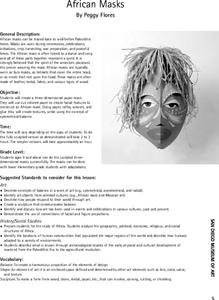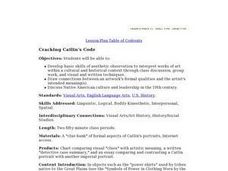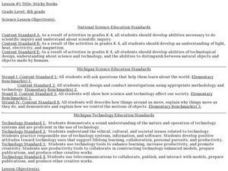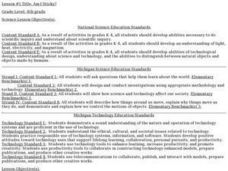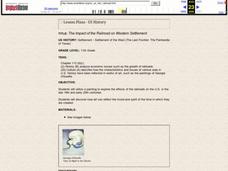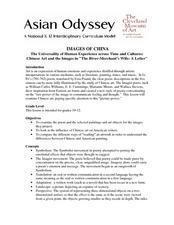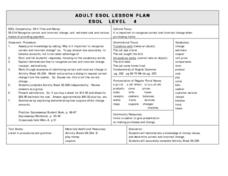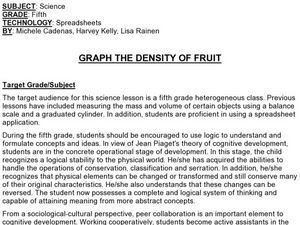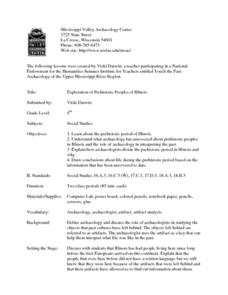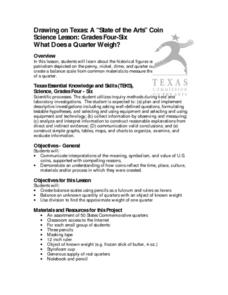Curated OER
African Masks
Fourth graders create three-dimensional paper African masks. They analyze the geographic, political, economic, religious, and social structures of Africa. they discover that masks were worn for various ceremonies.
Curated OER
Porcelain And Trade Economics
Students discover the concepts of importing and exporting through the study of Asian luxury goods, in particular porcelain. This lesson includes resource links to primay source images.
Curated OER
What is a Folktale?
Young scholars are read an apache folktale and discuss the characters in the story. Using the text, they identify the factors that make it a folktale and not a fairy tale. On a map, they locate where the Apache people live. As a class,...
Curated OER
Cracking Catlins's Code
Students create a chart comparing visual clues with artistic meaning. This lesson plan is designed to introduce students to the ways in which consistent patterns of gesture and pose chosen by an artist (specifically George Catlin)...
Curated OER
Political Protest Through Art
Learners examine how artists (painters or cartoonists) use artwork as a means of disseminating a political point of view in this lesson plan that uses primary source documents and examples of political cartoons.
Curated OER
Sticky Books
Fourth graders investigate items that are magnetic and those that are not. They determine the properties of the magnetic items. They create a digital book that demonstrates what they have learned about magnetism.
Curated OER
Am I Sticky
Fourth graders become familiar with magnets and their properties. They investigate what items are magnetic and non-magnetic and make generalizations about the properties. They utilize technology to develop an interactive digital book.
Curated OER
Is There Seaweed/Algae in Your Food?
Young scholars discover that seaweed/algae is a small part of the resources the oceans provide. By investigating common household products, students discover that human senses are not enough to detect the presence of seaweed/algae in food.
Curated OER
St. Michael, Prince of the Celestial Armies
Students describe this work of art as reflecting the beliefs of Mexicans in the viceregal period. They create their own sculptures in a lightweight material that shows themselves in an active pose.
Curated OER
Paper Structures
Students demonstrate that material strength varies with shape and arrangement.
Curated OER
The Impact of the Railroad on Western Settlement
Eleventh graders utilize a painting to explore the effects of the railroads on the U.S. in the late 19th and early 20th centuries. They discover how art can reflect the mood and spirit of the time in which they are created.
Curated OER
Comparing Chinese And Japanese Ceramics
Young scholars discuss the conception of beauty by considering and contrasting the
appearance and use of Chinese and Japanese ceramics in this lesson for the middle or high school classroom.
Curated OER
Images of China
Students examine the Chinese poem "The River-Merchant's Wife: A Letter" by Li Po while comparing the different ways of "reading" an artwork in order to understand the differences between Chinese and American painting.
Curated OER
Identifying Correct Change
Pupils analyze the importance of recognizing whether or not they have been given correct change. They brainstorm ideas for determining whether or not they have received correct change. Students model and practice dialog to request...
Curated OER
Graph the Density of Fruit
Fifth graders review the definition of mass and volume. They calculate and graph the density of various types of fruit while working in groups on a spreadsheet program. They look at how size of the fruit can be similar but the weight is...
Curated OER
Webbing out Electricity
Fourth graders identify electricity as a form of energy that is associated with common household products. They utilize technology as an aid in which they can graphically organize their thoughts.
Curated OER
Highways and Stop Signs
Fourth graders investigate conductors and insulators and distinguish between the two. They utilize the digital camera and other forms of technology to create a study guide on conductors to help students develop sound knowledge.
Curated OER
Searching For Power
Fourth graders explore different forms of energy and discover ways that natural resources are important. They research how your town would be affected by building your type of power plant.
Curated OER
Combining Geography and Literature by Mapping a Story
Students listen to or read a story on their own. Using the text, they describe the relative locations of the main events. In groups, they develop two and three dimensional maps of the story. They create a key and a title for their map.
Curated OER
ESOL Shape identification
Students review vocabulary shape cards. They match oral words of shapes with flash cards then they make and label their own set of shape flash cards and then review with a classmate.
Curated OER
Exploration of Prehistoric Peoples of Illinois
Eighth graders begin their examination of the prehistoric period in Illinois. As a class, they discuss the role of archaeology in history and how it helps learn more about native peoples. After examining each period, they develop their...
Curated OER
What Does a Quarter Weigh?
Students study the historical figures and symbols of U.S.
patriotism depicted on the penny, nickel, dime, and quarter coins. They
create a balance scale from common materials to measure the approximate weight
of a quarter.
Curated OER
Development
In this psychology worksheet, students complete 5 short answer questions on human's developmental stages and Kohlberg's theory.
Curated OER
Friction and Machines
Fifth graders experimentally determine the relationship of friction to the functioning of machines. They demonstrate that rollers can decrease frictional force and increase speed and research to discover other ways that friction can be...
